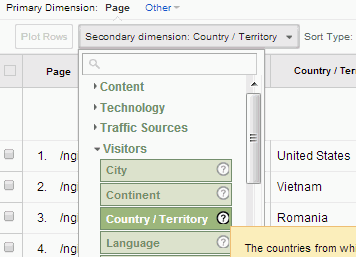The Importance of Secondary Dimension in Google Analytics for Your SEO
The Importance of Secondary Dimension in Google Analytics for Your SEO
Blog Article
Unlock Deeper Insights With Additional Measurement in Google Analytics
With the substantial area of information available in Google Analytics, the utilization of second dimensions can significantly improve your analytical capacities. These additional layers of information use a nuanced point of view that can illuminate detailed information within your primary metrics. By tactically integrating secondary dimensions into your analysis, you can discover beneficial understandings that may or else continue to be undiscovered. The capacity to analyze and dissect user habits with greater precision opens a world of opportunities for boosting and optimizing techniques efficiency.
Comprehending Key Vs. Additional Dimensions
When assessing information in Google Analytics, it is vital to identify in between additional and main dimensions to obtain much deeper insights right into individual actions. Key measurements are the main groups through which you can watch your data, such as source/medium, tool, or landing web page. These measurements provide the basic structure for arranging and recognizing your information. On the other hand, secondary measurements allow you to further dissect your primary dimension data. By adding a secondary dimension, you can layer on extra details to your key measurement, allowing a much more granular analysis. As an example, if your key dimension is the source/medium whereby users arrived on your site, adding a secondary measurement like geographical place can expose where those users lie geographically. When looking at the key measurement alone, this added layer of details can help you determine patterns, patterns, or abnormalities that may not have actually been obvious. As a result, leveraging both second and main dimensions in Google Analytics is crucial for comprehensive information analysis and educated decision-making.
Making Use Of Secondary Dimensions Effectively
By including second measurements together with main measurements, marketers and experts can dig deeper into the specifics of individual communications on their websites. Additional dimensions enable individuals to segment and filter main dimension information further, supplying a much more thorough view of user interactions, behaviors, and demographics.
Furthermore, secondary measurements make it possible for users to contrast and contrast different information points within a solitary report, helping with a much more thorough evaluation of individual habits patterns. By leveraging second measurements efficiently, businesses can reveal hidden understandings, maximize their advertising and marketing approaches, and enhance the overall customer experience on their websites.
Exploring Typical Second Dimension Combinations
To better evaluate user actions and patterns in Google Analytics, it is valuable to explore typical mixes of additional dimensions. Some typical additional measurement combinations that provide valuable insights include assessing website traffic sources with user locations to understand where website site visitors are coming from geographically and exactly how they discovered the site. Taking a look at individual behavior metrics with second dimensions such as rate of interests or demographics can aid in targeting particular target market sectors a lot more properly.
Using Additional Measurement in Custom-made News
Using second measurements in custom records allows for a more detailed evaluation of information in Google Analytics, enhancing the depth of understandings obtained. When creating personalized reports in Google Analytics, integrating additional measurements can provide an extra comprehensive view of how different dimensions connect with each various other. This attribute makes it possible for users to delve deeper right into their data and discover valuable correlations that may not be promptly obvious.
By applying secondary dimensions in personalized records, customers can gain a better understanding of their internet site or app traffic. For example, combining view it the main dimension of "source/medium" with the secondary dimension of "landing web page" can reveal which touchdown pages are doing ideal for web traffic see it here originating from particular sources. This insight can assist online marketers maximize their projects and boost overall conversion prices.

Enhancing Data Visualization With Secondary Measurement
When exploring information in Google Analytics custom-made reports, integrating secondary measurements not only provides a more detailed analysis however additionally improves the graph of understandings via data visualization. By including a secondary dimension to your records, you can enhance the method data exists, making it easier to determine patterns, trends, and correlations within your web site's efficiency metrics.
Second dimensions can assist you sector your information better, permitting a much deeper understanding of individual actions and interactions on your website. This boosted degree of granularity can be particularly valuable when trying to separate details variables that might affect your site's performance - Secondary Dimension in Google Analytics.

Verdict
In verdict, leveraging second dimensions in Google Analytics enables an extra detailed analysis of data, resulting in much deeper insights and more informed decision-making. Secondary Dimension in Google Analytics. By adding added layers of details to key information sets, online marketers and analysts can uncover concealed trends, patterns, and connections that offer a granular sight of user habits and communications. This boosted level of understanding allows optimization of projects and customized approaches for specific target market sectors, eventually boosting performance and conversion rates
On the various other hand, second dimensions enable you to further explore your key dimension information. By including a second measurement, you can layer on additional info to your main measurement, making it possible for a more granular basics evaluation. If your primary dimension is the source/medium through which users arrived on your website, adding a secondary dimension like geographical area can reveal where those customers are situated geographically. By integrating additional measurements together with main measurements, experts and marketing experts can delve deeper into the specifics of user communications on their web sites. Second measurements allow customers to sector and filter main dimension data better, offering an extra thorough sight of individual demographics, habits, and communications.
Report this page